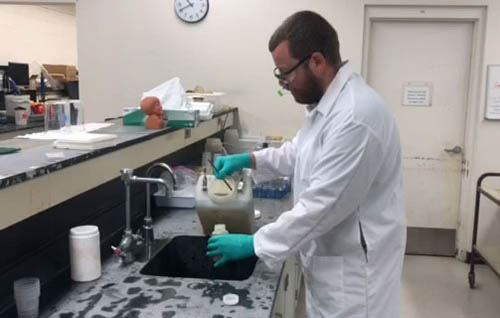 Samples of wastewater flowing into the massive Metropolitan Wastewater Treatment Plant in Saint Paul are part of three separate research studies to determine if the amount of SARS-CoV-2 genetic material in wastewater can be reliably quantified and related to the prevalence of COVID-19 in the plant’s service area.
Samples of wastewater flowing into the massive Metropolitan Wastewater Treatment Plant in Saint Paul are part of three separate research studies to determine if the amount of SARS-CoV-2 genetic material in wastewater can be reliably quantified and related to the prevalence of COVID-19 in the plant’s service area.
Current research suggests that people may start shedding the virus in their feces up to a week before symptoms appear.
Scientists might be able to detect when infection rates are starting to rise in the population, explained Steve Balogh, research scientist in the Met Council’s Environmental Services division (MCES). “Wastewater monitoring could be a complementary tool [to clinical testing] that policymakers could use to help determine when more protective measures need to be taken to slow the spread of the virus,” he said.
First wastewater samples collected in April
The Met Council sent its first weekly wastewater sample to Biobot, Biobot, based in Cambridge, Massachusetts, on April 21. Automatic sampling equipment collects a small amount of wastewater multiple times per day and consolidates it into a 2.5-gallon container. Representative samples are taken from this mixture after a 24-hour period.
Although there isn’t enough data yet to reliably determine a trend, it will be telling if there is a change as businesses continue to open up and larger gatherings of people become common, Balogh said.
Scientists in Minnesota pursuing similar research
Closer to home, samples from the Metro Plant taken the same day as the Biobot samples are also being sent to a University of Minnesota Medical School research lab in Duluth. The lab has enrolled 22 wastewater treatment plants across the state to provide samples. The Council plans to continue with this project at least through December.
“Having independent measurements from the same composite sample will give some indication of the uncertainty of the data,” Balogh said.
Third research project to look at sewage sludge
MCES staff are also making measurements of SARS-CoV-2 of their own, with assistance from the University of Minnesota Genomics Center in Minneapolis. The viral genetic material is being measured in samples of both wastewater as it comes into the plant and of gravity-thickened sludge, material that settles out during the initial stages of wastewater treatment.
Balogh said this in-house project should be a long-term, cost-effective, and more definitive alternative to the other projects.
“Our goal is to be producing high-quality, defensible data by later this fall,” Balogh said. “If we have a way to anticipate infection trends, we may be able to help save lives.”
Updated September 2, 2020